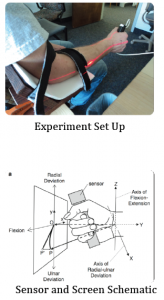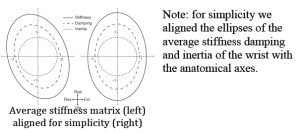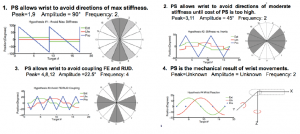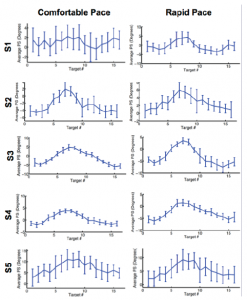Jenny Pate and Dr. Steven Charles, Department of Mechanical Engineering
Introduction
Many Americans struggle with wrist injuries that severely impact their ability to work (typing, writing, etc.) and perform basic everyday functions (eating, holding, etc). These injuries often result from repeatedly forcing the wrist to move in unnatural ways. To properly combat these challenges and improve the lives of wrist patients, a better understanding of the human wrist is required. Extensive research has been conducted in arm reaching movements, but limited documentation has been presented regarding the human wrist. In particular, although it appears that humans choose certain wrist movements over others, it is unclear which paths are preferred, why they are preferred, and why humans combine wrist and forearm movements when forearm movements are not necessary.
Pointing with the wrist only requires 2 degrees of freedom (DOF) of the wrist, yet we have found that subjects utilize forearm rotation even though it is not necessary for pointing. We hypothesize that subjects use the redundant DOF to avoid uncomfortable wrist orientations.
To test this hypothesis, we performed an experiment to measure the use of forearm rotation in a task that only required wrist rotations.
Methods
Five young, healthy, right handed subjects participated in this study. Each subject was centered in front of a screen with his/her right arm in an apparatus that restrained translation of the proximal forearm but allowed for the distal forearm to rotate in pronation-supination.
Subjects grasped a handle instrumented with a sensor and made center-out movements to 16 peripheral targets signaling on the screen requiring 15 degrees of flexion-extension and/or radial/ulnar deviation. Each subject made 15 movements to each target at comfortable and fast speeds. We then extracted forearm and wrist angles from motion sensor data.
Hypotheses
We formulated four hypotheses to explain PS behavior. In each diagram the blue line is the anticipated pronation-supination (PS) behavior, green is Flexion-Extension, and Red is Radial-Ulnar deviation. The dark regions outline where we would see max PS of the wrist.
Results
We measured forearm and wrist movements of five subjects as they pointed to 16 peripheral targets. Average PS position at each target is shown in figures below. Error bars show ±SD.
The data show that PS:
- Is significant in tasks that only require wrist movements.
- Has a repeatable amplitude at each target.
- Exhibits a sinusoidal pattern.
- Is stereotyped between subjects.
- Has one period per revolution and max and min peaks around targets 9 and 1, respectively.
Discussion
We found that subjects do use significant pronation-supination (PS) in a repeatable and stereotyped manner, even though PS was not required to complete the assigned task. However, the amplitude and frequency of PS behavior did not match hypotheses 1-3. It is possible that hypothesis 4 could explain PS amplitude, but further research is required to model the forearm and wrist dynamics to test this hypothesis.
This research was presented at the 2011 Neural Control of Movement Conference held in San Juan, Puerto Rico.




